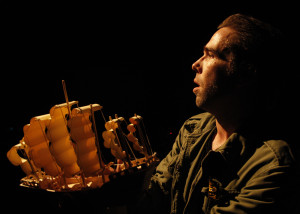Things Get Medieval in Sarah Ruhl’s Three-Act Passion Play at Chance Theater
by Joel Beers
 Queen Elizabeth I, Ronald Reagan and Hitler walk into a theater and see Jesus on a cross . . .
Queen Elizabeth I, Ronald Reagan and Hitler walk into a theater and see Jesus on a cross . . .
While that sounds like the set-up for a terrible joke, it’s actually a fair description of Sarah Ruhl’s Passion Play. Clocking in at three hours and 10 minutes, there’s nothing cavalier about Ruhl’s work or the performance, which is worth nearly every minute invested.
I say nearly because any play comprised of three roughly 50-minute acts set in 1575 England, 1934 Nazi Germany and late-20th-century American Empire is bound to have a bit of fat. But the strength of Ruhl’s energetic writing and the scope of her vision are so forceful that even those of us who sense old friend Panic Attack percolating when glimpsing that dreaded sentence in the program—”Running time: 3 hours. There will be two 10-minute intermissions”—will feel thoroughly engaged and entertained. And while the three separate acts, which overlap both thematically and content-wise, are each compact, well-told stories, they serve multiple purposes, from a valentine to the production of theater across the centuries to a chilling reminder of how art can be subverted, manipulated and seized as political capital.
One caveat: You ought to know a little about what a passion play is before you enter the theater (and, luckily, you came to the right place for that). Basically a representation of Christ’s crucifixion, blending readings from the Bible and staged re-enactments of significant events in the story—stretching as far back to the original set-up (the serpent in the Garden) through Christ’s eventual ascension—passion plays were a staple of villages in Medieval Europe. Even though awash in religious veneration and adoration, they served as one small flicker of artistic expression in a relatively dark time for anything but foraging for tubers and trying to avoid dying from the plague.
But passion plays got political after Henry VIII broke free of the Catholic Church. Such a Catholic pageant of iconography had no place in Anglican England, and they were banned in 1534, although some continued under the religious radar.
The first of Ruhl’s three passion plays is set in England in 1575. In this small Catholic village, Christ is played by John, a fisherman (Ben Moroski). His crippled, fish-gutting cousin (Casey Long) plays Pontius Pilate. Those two play the same characters of the play-within-the-play in all three acts, as do Camryn Zelinger, as Mary 1 (the virgin), and Katelyn Schiller, as Mary 2 (the whore). But while rehearsals of the passion play are the backdrop for each of Ruhl’s passions, their stories couldn’t be more different. In the first, Pontius schemes to bed Mary 1, as well as achieve his desire of playing the honored role of Christ. In the second, set in 1934 Germany, Pontius and John are closeted homosexuals (so closeted even they may not fully know it) as the drums of war are picking up their cadence. In the third, set in South Dakota from 1969 to 1984, they are brothers in love with the same woman as the drums of a far different war are once again beating.
While each story is self-contained, there are obvious thematic parallels. In each, at least one character yearns to break free from his or her provincial surroundings and strike out, to either see the world or to express his or her sexuality without fear of religious or political condemnation. Also in each, the passion play becomes ensnared in the cross-hairs of political propaganda, with the notable political figure of each era serving as a deus ex machina, from Queen Liz shutting down the first one to Hitler praising the second for its vilification of Jews to Reagan praising the third as promoting American values of family and religious devotion.
The suppression of religion, creativity and self-expression reverberates throughout the play, and it’s clear that, in Ruhl’s mind, it doesn’t matter if that suppression stems from church, state or the community: It’s all bad. There is a great deal more going on in each act, and things do get weird from time to time—from the sky erupting into red in the first to a completely bewildering but intense climax in the third punctuated by Jesus banging his mother as a scarred Vietnam vet brandishes a gun while Reagan calls play-by-play of a fictitious baseball game.
With so much going on, it’s a testament to director Trevor Biship and his design crew, as well as the stellar efforts of the outstanding cast (special mention to Long, a founding artist of the Chance, who contributes perhaps his strongest work ever in this show), that the intensely human dimension of each of the stories is not lost amid the loftier strokes of Ruhl’s vision.
And the punch line to the set-up in the first paragraph? Three hours later, you walk out of that theater blown away by something completely different.
Leave a Reply
